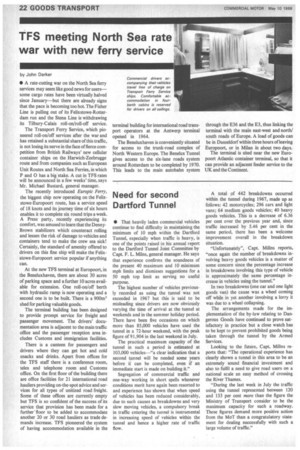Need for second Dartford Tunnel
Page 24

If you've noticed an error in this article please click here to report it so we can fix it.
• That heavily laden commercial vehicles continue to find difficulty in maintaining the minimum of 10 mph within the Dartford Tunnel, especially when traffic is heavy, is one of the points raised in his annual report to the Dartford Tunnel Joint Committee by Capt. F. L. Milns, general manager. He says that experience confirms the soundness of the present 40 maximum and 10 minimum mph limits and dismisses suggestions for a 50 mph top limit as serving no useful purpose.
The highest number of vehicles previously recorded as using the tunnel was not exceeded in 1967 but this is said to be misleading since drivers are now obviously varying the time of arrival at the tunnel at weekends and in the summer holiday period. There have been five occasions on which more than 85,000 vehicles have used the tunnel in a 72-hour weekend, with the peak figure of 91,904 in the last weekend in July.
The practical maximum capacity of the tunnel in such a period is estimated at 103,000 vehicles—"a clear indication that a second tunnel will be needed some years before it can be completed, even if an immediate start is made on building it."
Segregation of commercial traffic and one-way working in short spells whenever conditions merit have again been resorted to and experience has shown that when speed of vehicles has been reduced considerably, due to such causes as breakdowns and very slow moving vehicles, a compulsory break in traffic entering the tunnel is instrumental in increasing speed of vehicles within the tunnel and hence a higher rate of traffic flow.
A total of 442 breakdowns occurred within the tunnel during 1967, made up as follows: 42 motorcycles; 296 cars and light vans; 64 medium goods vehicles; 40 heavy goods vehicles. This is a decrease of 6.36 per cent over the previous year and, since traffic increased by 5.46 per cent in the same period, there has been a welcome improvement overall in the breakdown situation.
"Unfortunately", Capt. Millns reports, "once again the number of breakdowns involving heavy goods vehicles is a matter of some concern since the percentage increase in breakdowns involving this type of vehicle is approximately the same percentage increase in vehicles using the tunnel."
In two breakdowns (one car and one light goods van) the cause was a wheel coming off while in yet another involving a lorry it was due to a wheel collapsing.
The arrangements made for the implementation of the by-law relating to Dangerous Goods have continued to prove satisfactory in practice but a close watch has to be kept to prevent prohibited goods being taken through the tunnel by the Armed Services.
Looking to the future, Capt, Minns reports that: "The operational experience has clearly shown a•tunnel in this area to be an extremely sound financial investment and also to fulfil a need to give road users on a national scale an easy method of crossing the River Thames.
"During the last week in July the traffic using the tunnel represented between 120 and 133 per cent more than the figure the Ministry of Transport consider to be the maximum capacity for such a roadway. These figures demand more positive action from the MoT than a congratulatory statement for dealing successfully with such a large volume of traffic."












































































































